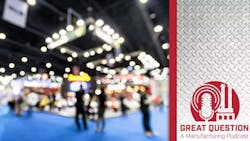Podcast: Show look-ahead—AI, robots, software, and more
The International Manufacturing Technology Show is one of the largest manufacturing technology confabs in the world, featuring 1.2 million square feet of exhibit space. The show attracts attendees from more than 110 countries and showcases over 1,800 exhibiting companies. This year’s attendees will include Smart Industry Editor-in-Chief Robert Schoenberger; Thomas Wilk, editor-in-chief of SI sister brand Plant Services; and Robert Brooks, who is editor-in-chief of two other affiliated brands, American Machinist and Foundry Management & Technology. In this episode, the EICs discuss what they’re looking forward to seeing at IMTS 2024.
Below is an excerpt from the podcast:
Robert Schoenberger: Robert, you've been going to this for years. Why don’t we just start with you? Can you give people a little bit of background about what IMTS is and the scope and the size of the show?
Robert Brooks: Sure. It started out, I think, just after World War II; 1946 or 48, I think, was the first year. I know the first Iteration, the first manifestation of it was in Cleveland, and then it settled in Chicago on the following cycle, and that has not changed.
Podcast: Technology's role in closing the skills gap
You described it well, but still, it's sort of hard for people who've never been there to grasp it. It runs for six days, and it's got any number of parallel activities ongoing. There are people from all over the world. The exhibits are large, and there's people everywhere. And with 100,000 attendees, it feels like they're all there at the same time, even though that's obviously not what's happening.
There are external dynamics, and there are internal dynamics. The internal dynamics are mostly what I'm going to be paying attention to, at least while I'm there. That is, you know, what people are introducing and what they are emphasizing, and what they are trying to get people to understand about their work over the previous two years. The external dynamics have to do with how many people are there, and who showed up and who didn't show up, and what has changed from two years before and so on and so forth.
See also: Additive manufacturing merger craze doesn’t add up to big payouts
And that will probably be read in the following weeks about the state of the sector, because in all honesty, there is something of a recession going on here. There's a shortage of demand for orders for the people who are meant to be buying machine tools and robots and related technologies. And that means that the number of orders for machine tools and robots and related technologies is down. So that's the external dynamics.
The internal dynamics that I'm following will be like “What trends have been continued from 2022? What trends are arriving now?” Just for one or two examples of that, in 2022, it seemed like everybody had embraced collaborative robotics. There were cobots on every corner, and that made a lot of sense. And I think it still makes a lot of sense. I'll be interested to see how that trend has gone to any further step. I've got a couple of interviews scheduled with robotics developers. One of them is on embargo, so I can't say too much about it now, but they seem to have gone so far beyond it that they're not even really there. It's all going to be in the cloud, and all of the programming that a shop or a manufacturer would have for their robots would be done in the cloud, which is sort of fascinating.
See also: Episode 3 of (R)Evolutionizing Manufacturing: All About AI
Another trend that I'm anxious about seeing is where we are with artificial intelligence. Not to toss this off too lively, but obviously artificial intelligence is not new, but up until this moment, there has been this huge gap between what the users want to do and think they can do, and what the developers are trying to make them understand and, in their words, embrace. You've got to jump all the way into the deep end with this in order to be an AI beneficiary. There's obviously applications and implications of AI in software, in hardware, in automation, and I'll be trying to tease out some threads that I can work together.
RS: Tom, you've been a few times. What’s your take on IMTS, and what are you expecting to see there this year?
Thomas Wilk: My brand focuses on industrial asset management, and a lot of the shows that I go to are focused on thought leadership in that area. What are the applications of condition monitoring technology? What new hardware and tools are emerging in this space to help industrial professionals manage their machines and also manage quality and productivity? In this case, you've got a lot of familiar names on that circuit who are now going to be embedded in this larger context, which Robert just scoped out, which is the machining industry.
See also: IT/OT convergence needs a human-centered approach
So, the conversations I'm hoping to have with both familiar names and some new faces are, “How are industrial facilities overall perceiving and acting on the use of machine health data to drive productivity, to drive capital planning?” In addition to, quite frankly, “How do you get the repair work done?” Robert Brooks, you mentioned that there was a sort of shortage of orders. For a lot of my readers, that's a blessing in disguise because when there's no orders coming in, it's a chance to do shutdowns and turnarounds and take care of the machines.
I think some of the names that I'm looking forward to seeing at the show specifically are Brightly. They focus on maintenance management. It's a software suite. It's a company owned by Siemens, and a good friend, Corey Dickens, is going to be there. We did a podcast with him about specifically applying industrial asset management standards to micro brewing techniques and how custom craft brewers can adopt those technologies to maintain productivity and quality. He's going to answer the question, “When it comes to maintenance work orders, that's a very specific kind of data, machine health, once you’ve repaired the machine and started it up again, what do you do with the information to help inform other parts of operations, energy efficiency, sustainability, and again, capital planning?”
About the Podcast
Great Question: A Manufacturing Podcast offers news and information for the people who make, store, and move things and those who manage and maintain the facilities where that work gets done. Manufacturers from chemical producers to automakers to machine shops can listen for critical insights into the technologies, economic conditions, and best practices that can influence how to best run facilities to reach operational excellence.
About the Author
Scott Achelpohl
Head of Content
I've come to Smart Industry after stints in business-to-business journalism covering U.S. trucking and transportation for FleetOwner, a sister website and magazine of SI’s at Endeavor Business Media, and branches of the U.S. military for Navy League of the United States. I'm a graduate of the University of Kansas and the William Allen White School of Journalism with many years of media experience inside and outside B2B journalism. I'm a wordsmith by nature, and I edit Smart Industry and report and write all kinds of news and interactive media on the digital transformation of manufacturing.

